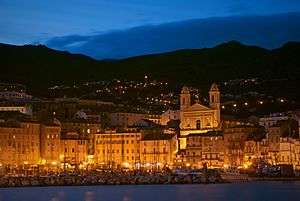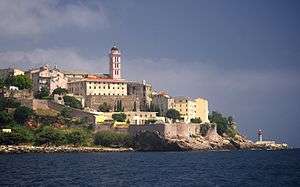Bastia
Bastia is a city on the French island of Corsica.

Understand
Bastia is the second largest city by population in Corsica with over 43,000 inhabitants. It is a small city and good for pedestrians. Tourism has not brought much prosperity to the city, and unemployment remains high by French standards.
Bastia received its name from a Genoese construction of a "bastiglia" in the 1300s. Both Bastia and bastiglia are cognates of the English "bastion". Bastia was the principal capital of Genoese Corsica, and it became French only in the late 1760s.
The small fortifications and pleasant harbor-side areas make for a pleasant stroll. The afternoon siesta is a serious daily event in Bastia, and one should be careful to respect shop hours (e.g. supermarket) in order to be able to buy necessities at normal prices.
Get in
By plane
- 🌍 Bastia Airport ("Poretta" BIA IATA). has seasonal budget flights from Europe and year-round scheduled flights from mainland France. The airport is 20 km south of the city on the main coast highway. A ricketty old bus runs approx hourly to town centre, taking 20 mins, for €9 per person - cash only, to the driver. Find the timetable on the airport website. For two or more people, a taxi will probably be better value, especially if your accommodation in Bastia is away from the centre.
By boat
The main ferry routes from Bastia are to Marseille, Toulon, and Nice in France, and to Genoa, Savona, Livorno and Piombino in mainland Italy - the latter via Portoferraio on Elba. No ferries to Sardinia, these sail from Bonifacio on the S tip of Corsica.
The ferries are of uneven quality, even within the same company. They get very busy during the summer, so book early, even if you're just a foot passenger without vehicle or cabin.
- 🌍 Ferry terminal, Gare Maritime. Entry to the port is at the north end of the New Harbour. The passenger terminal is a cramped affair, but has basic facilities. Foot passengers may exit the port by the turnstile opposite Town Hall.
A clutch of car rental offices can be seen on the streets facing the turnstile exit. They're open 8 am to 8 pm Mon-Sat, none are open Sunday.
By train
A narrow gauge train service links Bastia with Ajaccio, Corte, Calvi, L'Île-Rousse. The train takes passengers through beautiful valleys and over spectacular passes. However, the fare all the way to Ajaccio is pricey at €22 one-way, and the ride's comfort level is reminiscent of a horse-drawn carriage on a dirt road. As noted in the Corsica page, the locals call it "the shivering one" (U Trinighellu) for good reason.
- 🌍 Train terminal, Bastia, Pays Bastiais, Gare Ferroviaire CFC - Chemins de Fer Corse, Place de la gare, ☎ +33 4 95 32 80 61, +33 4 95 32 80 55, fax: +33 4 95 34 01 14.
By bus
There are bus services to/from Calvi, L'Île-Rousse, Saint-Florent on the northwestern part of the island, Solenzara, Porto-Vecchio on the southeast, occasional services to the Cap Corse on the North .
- 🌍 Bus terminal, Bastia, Pays Bastiais, Gare Routière de Bastia, 1 rue du Nouveau Port, 20200 (Just off the Place St Nicolas and the ferry terminal), ☎ +33 4 95 54 54 54.
Get around
Explore the town on foot. Much is pedestrianised, and the vehicle routes get very congested.
The city bus network is operated by Société des Autobus Bastiais (phone: +33 4 95 31 06 65).
A tramway runs from Bastia railway station, for some 25 km (16 mi) south along the coast to Casamozza, where it connects with the mainline train between Bastia and Ajaccio. The tram passes within 2 km of Bastia airport, the nearest stop being Lucciana, but there's no connecting link so it doesn't work as a means of "Getting in".
See

The sights of Bastia are grouped around the 🌍 Vieux Port. - the Old Port. The quayside is shabby chic, with tall, faded buildings (many housing restaurants) surrounding a marina with posh yachts. It's particularly charming at dusk and early evening. The twin towers of the 🌍 Cathedral (St Jean Baptiste, St John the Baptist). stand prominently here. The area just north is the historic neighbourhood of Terra Vecchia: notable churches are the Oratoire de l'Imaculee Conception and the Confrerie St-Roch.
To the south dominating the harbour is the citadel, built by the Genoese in the 15-17th Cs. Climb up to it by the street or by the Romieu gardens, to enter via the imposing gateway. Within is the square of Place du Donjon, and the entrance to the Palais de Gouverneurs, which now houses the city museum. Deeper within the warren of alleyways are the former cathedral 🌍 Eglise Ste-Marie (Church of Santa-Maria). and the Ortoire Baroque Ste-Croix.
Do
Explore Cap Corse, the rugged peninsula stretching north of Bastia. A very twisty road, the D80, makes for a scenic but occasionally nerve-wracking circular drive. Allow about four hours for this, have at least half a tank of fuel aboard before you start, and do not rush. Going anti-clockwise, follow the main coast road north from Bastia port. This section along the east coast, though twisty, is mostly broad enough for traffic to pass with comfort, and the prospect below is not too vertiginous. It passes through Erbalunga and Pietracorbara to Santa Servera, where the road forks: one branch crossing the mountains via Luri to the west coast, the other continuing along the coast to Macinaggio. Buses from Bastia ply the road this far. Then this road also climbs inland, a cul-de-sac road branches off to the north cape at Barcaggio, and the going gets serious. The route back south along the west coast is narrow, twisting and turning high above the restless sea with no barriers between you and a very long drop. Villages along the way, clinging to the mountainside with scenic but precarious harbours, are Centuri, Pino, Canari and Nonza. Finally the road descends to Patrimonio where you'll be relieved to join the main highway D81 for the last hill-climb back over to Bastia. A short detour the other direction (towards Ile Rousse & Calvi) takes in the village of Saint-Florent.
There is an argument for driving the Cap Corse route clockwise, so you'd be on the landward side of the road away from the cliff-edge. But the scariest parts are effectively single-track, with oncoming traffic and a mad white van on your tail.
Buy
Eat
The Vieux Port restaurants major on seafood, but there's Tex-Mex and mainstream Italian.
- Le Jean Bart, ☎ +33 4 95 31 36 31. For wonderful moules-frites (mussels and French fries) and puddings.
Drink
Sleep
- Pietracap, 20 Route de San Martino. Hotel with a swimming pool. Closed mid-Dec to Feb.
- Sud Hôtel, Avenue de la Libération (1 km from centre of town), ☎ +33 4 95 30 20 61, e-mail: info@sudhotel-bastia.com.
- Hotel des Gouverneurs, 3 bis rue des Turquines (in citadel overlooking old port). Great comfort, in great location overlooking old port - if you can find it! In the pedestrianised citadel, nearest vehicle drop-off 200 m away.
Go next
Bastia is a good starting point for a tour of Corsica, but you'll need your own car - or to be a very fit cyclist - to get around this rugged island.
Public transport options are much more limited, but a daily bus runs to Calvi (€20) and all other major Corsican cities, and trains run daily to Corte and Ajaccio.